The next-gen MacBook Pro with Retina Display Review
by Anand Lal Shimpi on June 23, 2012 4:14 AM EST- Posted in
- Mac
- Apple
- MacBook Pro
- Laptops
- Notebooks
Battery Life
For much of the past year I haven’t been pleased with just how good Apple’s caching has become both on OS X and iOS. Aggressively caching our test web pages produces artificially inflated battery life numbers and that’s no fun for anyone. I’m happy to say that I’ve fixed that problem with our OS X battery life tests.
The suite is completely redone although conceptually it’s quite similar to what I’ve run in the past. I have three separate workloads: light, medium and heavy, each one representing a different stress level on the machine and all three giving you a decent idea of the dynamic range of battery life you can expect from one of these notebooks. All three tests are run with the displays set to 100 nits (a little above the halfway brightness point on most MacBook Pros).
The light and medium suites are inherently related - they use the same workload and simply vary the aggressiveness of that workload. The light test hits four different websites every minute, pausing for nearly the entire time to simulate reading time. Flash is enabled and present on three of the sites. The long pause time between page loads is what really makes this a light test. Web browsing may be the medium for the test but if all you’re doing is typing, watching Twitter update and maybe lazily doing some other content consumption this is a good representation of the battery life you’ll see. It’s a great way of estimating battery life if you’re going to be using your notebook as a glorified typewriter (likely a conservative estimate for that usage model).
The medium test hits the same webpages (Flash and all) but far more aggressively. Here there’s less than 10 seconds of reading time before going onto the next page. It sounds like a small change but the impact on battery life is tremendous.
Both the light and medium tests are run in their default state with processor graphics enabled, as well as with the discrete GPU forced on. I run with the dGPU on as well because it’s far too often that a single application open in the background will fire up the dGPU and contribute to draining your battery. The goal here is to deliver useful numbers after all.
The final test is very similar to our old heavy multitasking battery life tests, but with some updates. Here I’m downloading large files at a constant 1MB/s from a dedicated server, while playing back a looped 1080p H.264 movie (the Skyfall trailer) all while running the medium battery life test. The end result is a workload that gives you a good idea of what a heavy multitasking usage model will do in terms of battery life. I’ve found that OS X tends to fire up the dGPU anyway while running this workload so I saw no reason to run a separate set of numbers for processor and discrete graphics.
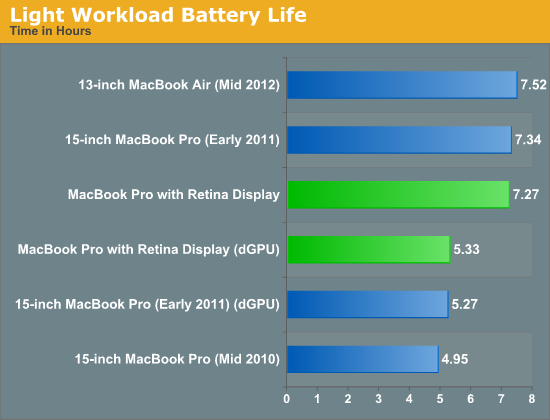
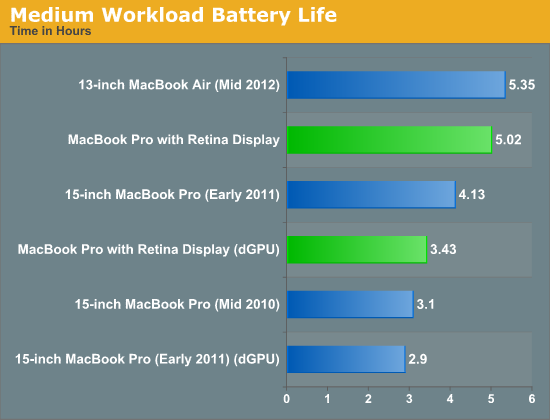
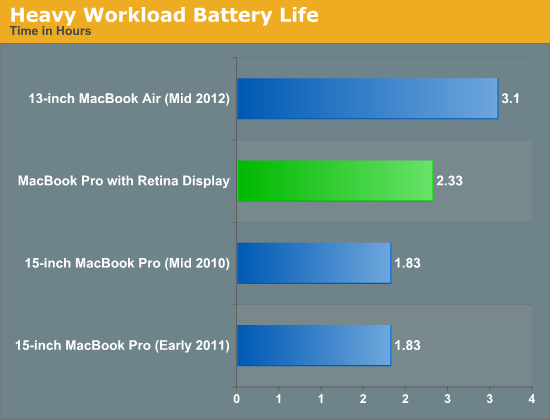
Overall the rMBP pretty much behaves as expected. Apple claims up to 7 hours of battery life and using our light workload we see a bit over that. Fire up the dGPU and even a light workload will get cut down to around 5.5 hours. Moderate usage will drop battery life to around 5 hours, and if you fire up the dGPU you’ll see that cut down to 3.5. The heavy multitaskers in the audience will see a bit above 2 hours out of a single charge. Note that all of these numbers are at 100 nits, drive the 2880 x 1800 panel at its full brightness and you can expect a tangible reduction in battery life.
The rMBP’s integrated 95Wh battery is ginormous by today’s standards, but it’s really necessary to drive both the silicon and that impressive panel. Subjectively I did find the rMBP lasted longer than last year’s MacBook Pro, despite the similar max battery life ratings. My experiences were echoed by the results in our tests.
I suspect most users will see around 5 hours of battery life out of the system compared to a bit under 4 hours out of last year’s machine. At minimum brightness, typing a long document (similar to what I’m doing right now) you can significantly exceed Apple’s 7 hour estimate. As always it really depends on usage model. Professional users doing a lot of photo and video editing aren’t going to see anywhere near the max battery life, while the writers and general users will be quite happy.
One trick to maximizing battery life on light or moderate workloads is to keep an eye on what the discrete GPU is doing. I still find that OS X will wake up the discrete GPU far too frequently, even when in my opinion its services aren’t needed. As always I turn to Cody Krieger’s excellent gfxCardStatus app for keeping an eye on which GPU is driving the panel. The app has been updated and is now fully compatible with the rMBP.


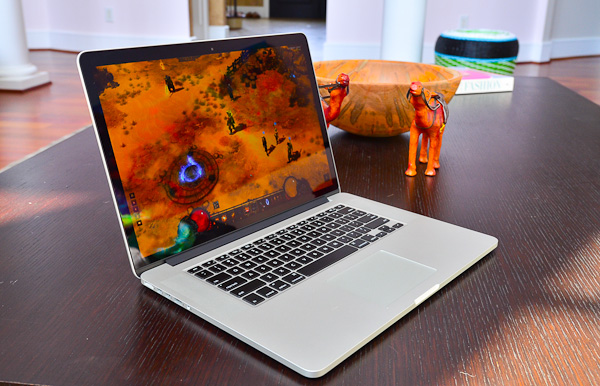
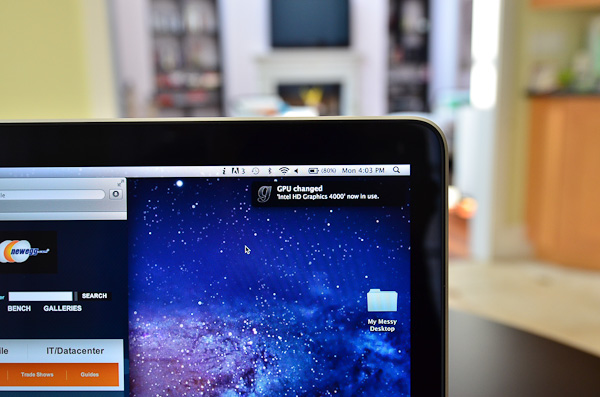








471 Comments
View All Comments
Fx1 - Monday, June 25, 2012 - link
It makes a big difference to the glare when you take away that glass. Why don't you go have a look at a rmbp and see how thin the lid is and you too will be impressed. A LOT of work must going into designing these notebooks. Why don't you spend you time bitching at the windows notebook makers and see how CRAP their designs are. Because they deserve it. Full Stop.Spunjji - Tuesday, June 26, 2012 - link
Why don't you go and eat a dick, child.gstrickler - Wednesday, June 27, 2012 - link
It's not a matte screen. Matte screens are etched to diffuse the light in many directions. This makes them slightly less "sharp", and lowers their effective brightness slightly. The Retina display in the new MBP has a low reflectance flat surface, not a matte surface. It's an important difference as an etched surface would compromise the sharpness of such a high DPI display.Spunjji - Monday, June 25, 2012 - link
I give up. Too many fanboys on both sides.jjbwbc - Monday, June 25, 2012 - link
I bought one of these guys and I really love the display but I cannot for my life see if this is glass or plastic or what makes the outer layer of this display.How fragile is it? I mean, it seems like a combination of durable and extremely fragile too. Makes me nervous... can anyone weigh in on how fragile the screen on this guy is compared to regular LCDs?
Constructor - Thursday, June 28, 2012 - link
It's definitely glass, and likely of the 'Gorilla' variety. It will still scratch or break if you try hard enough. But with no access to Apple's internal QA information we'll have to wait until someone actually manages to break theirs to really know...! ;-)SimaYi - Monday, June 25, 2012 - link
I'm disappointed in this review, as I was very much hoping to get some advice about whether this laptop can run recent games at 2880x1800.The only frame rates mentioned for this resolution were Half Life 2 (42 fps) and Diablo 3 (18 fps).
@Anand, is there any chance you will update this article with some detailed feedback about gaming at 2880x1800, and framerates for running recent Windows games in bootcamp at this res?
seapeople - Monday, June 25, 2012 - link
No, it can't run recent games at 2880x1800. This is not something that needs to be benchmarked; it is obvious from the combination of a middle-of-the-road laptop graphics card and the highest resolution notebook screen ever made.wfolta - Monday, June 25, 2012 - link
And you got this idea, despite the article mentioning Diablo III (about as recent of a game as you can get)? It runs Diablo III (Normal Act III) at 20+ FPS, with most settings cranked to max. It runs other recent games fine. Perhaps you should give details of what games you mean when you say "recent"?And the fact is you can run games at lower resolutions (which still look better at that resolution than if you only had that many pixels) and drop a few settings and double your frame rate.
SimaYi - Tuesday, June 26, 2012 - link
Thanks very much for the feedback!Are you saying from personal experience that it runs D3 on High at 20fps? How about if you reduce the settings, say with no AA and lower setttings, can it run D3 above 30fps?
For most games, 25-30 fps is quite playable. Above 30fps is great.
As for "recent" games, I would be extremely interested to know the performance at 2880x1800 (on low or med settings), for games like Skyrim, DXHR, RAGE, Arkham City, BF3, Sniper Elite V2, ME3, Risen 2, MW3, Witcher 2, Civ 5.
Never purchased a mac laptop before and this is the first time I'm seriously considering it, primarily because of the display. However, if I can't run any games at 2880x1800, it seems like a waste.
Trying to decide between either buying an MBP or a Windows laptop with 1080p display and decent GPU, along the lines of a DV6t (Nvidia 650m) or Envy 15 (AMD 7750m).
I wouldn't call the 650m necessarily "middle of the road," as it's one of the fastest mobile cards currently available for laptops that are not bulky desktop replacements. Do Mac laptops run games slower on bootcamp compared to Windows laptops with the same card?